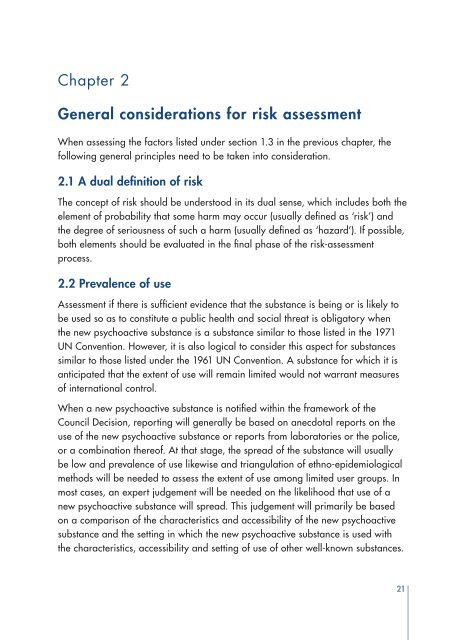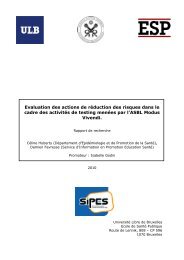Risk assessment of new psychoactive substances - EMCDDA - Europa
Risk assessment of new psychoactive substances - EMCDDA - Europa
Risk assessment of new psychoactive substances - EMCDDA - Europa
- No tags were found...
Create successful ePaper yourself
Turn your PDF publications into a flip-book with our unique Google optimized e-Paper software.
Chapter 2General considerations for risk <strong>assessment</strong>When assessing the factors listed under section 1.3 in the previous chapter, thefollowing general principles need to be taken into consideration.2.1 A dual definition <strong>of</strong> riskThe concept <strong>of</strong> risk should be understood in its dual sense, which includes both theelement <strong>of</strong> probability that some harm may occur (usually defined as ‘risk’) andthe degree <strong>of</strong> seriousness <strong>of</strong> such a harm (usually defined as ‘hazard’). If possible,both elements should be evaluated in the final phase <strong>of</strong> the risk-<strong>assessment</strong>process.2.2 Prevalence <strong>of</strong> useAssessment if there is sufficient evidence that the substance is being or is likely tobe used so as to constitute a public health and social threat is obligatory whenthe <strong>new</strong> <strong>psychoactive</strong> substance is a substance similar to those listed in the 1971UN Convention. However, it is also logical to consider this aspect for <strong>substances</strong>similar to those listed under the 1961 UN Convention. A substance for which it isanticipated that the extent <strong>of</strong> use will remain limited would not warrant measures<strong>of</strong> international control.When a <strong>new</strong> <strong>psychoactive</strong> substance is notified within the framework <strong>of</strong> theCouncil Decision, reporting will generally be based on anecdotal reports on theuse <strong>of</strong> the <strong>new</strong> <strong>psychoactive</strong> substance or reports from laboratories or the police,or a combination there<strong>of</strong>. At that stage, the spread <strong>of</strong> the substance will usuallybe low and prevalence <strong>of</strong> use likewise and triangulation <strong>of</strong> ethno-epidemiologicalmethods will be needed to assess the extent <strong>of</strong> use among limited user groups. Inmost cases, an expert judgement will be needed on the likelihood that use <strong>of</strong> a<strong>new</strong> <strong>psychoactive</strong> substance will spread. This judgement will primarily be basedon a comparison <strong>of</strong> the characteristics and accessibility <strong>of</strong> the <strong>new</strong> <strong>psychoactive</strong>substance and the setting in which the <strong>new</strong> <strong>psychoactive</strong> substance is used withthe characteristics, accessibility and setting <strong>of</strong> use <strong>of</strong> other well-known <strong>substances</strong>.21







